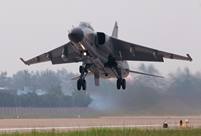

BEIJING, July 13 -- China's foreign trade volume continued to drop in the first half (H1) of the year, but an unexpectedly strong exports rebound in June was an encouraging sign for the pressured economy, official data showed on Monday.
Total foreign trade dropped 6.9 percent year on year to 11.53 trillion yuan (1.89 trillion U.S. dollars) in the first six months of 2015, slipping further from a 6-percent decline in the first quarter, according to data from the General Administration of Customs (GAC).
Exports rose slightly by 0.9 percent from a year ago, but imports slumped 15.5 percent, weighed down by a gloomy global climate and feeble domestic demand.
The trade surplus expanded 1.5 times to 1.61 trillion yuan, data showed.
GAC spokesperson Huang Songping described the situation as "grim and complicated" under the sluggish global economy during a press conference.
Huang attributed the import decline to shrinking domestic demand hurt by unsolved industrial overcapacity as well as falling commodity prices in the global market.
"Cheaper commodities dragged down China's import growth by 10.4 percentage points," Huang said. The crude oil price has slumped around 50 percent and iron ore has dropped over 40 percent from last July.
Despite an economic slowdown, China maintained a strong appetite for commodities. In H1, its crude imports gained 7.5 percent year on year to 163 million tonnes, and soybean imports climbed 2.8 percent to 35.16 million tonnes.
Exports were less troubling due to mild growth but were still plagued by anemic external demand.
The world is still trying to drag itself from the mire of the financial crisis with depressed trade and lowered demand in both developed and emerging economies, Huang said.
Exports were also curbed by rising salaries of Chinese workers and the appreciation of the yuan, Huang said.
The official exchange rate of the yuan against the U.S. dollar, the euro and the yen strengthened by 0.2 percent, 6.9 percent and 2.2 percent respectively during the past 6 months.
Liu Liu, macro researcher with CICC, said the significant appreciation will put some pressure on the recovery in exports and expected export growth to remain low in the short term.
Although China was still far from breaking its downward spiral in foreign trade, there were some encouraging signs in June.
Exports rose 2.1 percent from a year earlier, ending a three-month losing streak, and the decline in imports narrowed to 6.7 percent from an 18.1-percent slump.
The trade surplus jumped by 45 percent to 284.2 billion yuan, the GAC data showed.
Given improvement in June, Huang expects China's foreign trade to perform better in the second half thanks to supportive efforts by the government.
China has encouraged high-tech sectors to replace simple processing and focus more on exports to emerging economies to offset shrinking demand from developed ones.
Exports to Southeast Asia, India and Africa grew by 9.5 percent, 10.7 percent and 12.9 percent respectively in H1. Trade with countries covered by China's Belt and Road Initiative was even more robust, as exports to Bangladesh, Pakistan, Israel and Saudi Arabia saw average growth of 17 percent.
But Huang said China still faces difficulties as trade with the European Union and Japan, two of its major trading partners, tumbled and the global economy remained dim.
Foreign trade has been one of the most forceful economic drivers for China, bringing double-digit growth for decades. However, a lingering world trade downturn and weakened advantages of homegrown enterprises have led to concern.
Analysts have worried that disappointing imports and exports may dent market faith in the economic outlook.
Given uncertainties in external demand, Qu Hongbin, chief China economist at HSBC, said China should continue its easing measures to stimulate domestic demand to prop up growth.
China's economy expanded 7.4 percent in 2014, the slowest rate for 24 years. Policymakers set the target for economic growth at approximately 7 percent this year and that for foreign trade at 6 percent.
So far, reaching the targets has not proved to be an easy task. An array of earlier economic indicators for industrial output, retail sales and factory activity suggested the slowdown still remains.
The National Bureau of Statistics is scheduled to release GDP and other major indicators for H1 on Wednesday amid concerns that growth may dip to less than 7 percent.
 Campus belle of Xiamen University gets popular online
Campus belle of Xiamen University gets popular online Who says moms cannot be trendy and hot?
Who says moms cannot be trendy and hot? Stunning photos of China's fighter planes
Stunning photos of China's fighter planes Humanoid robot Yang Yang appears in Shanghai
Humanoid robot Yang Yang appears in Shanghai Enteromorpha hits Qingdao coast
Enteromorpha hits Qingdao coast Ten misunderstandings about beer
Ten misunderstandings about beer First batch of female combat pilots with duel degrees fly Flying Leopard
First batch of female combat pilots with duel degrees fly Flying Leopard Campus belle in HK goes viral online
Campus belle in HK goes viral online Top 10 secrets of longevity
Top 10 secrets of longevity Can Abe face history at Sep 3 parade?
Can Abe face history at Sep 3 parade? It's the teats! Fresh-squeezed goat milk a hit on Xi'an streets
It's the teats! Fresh-squeezed goat milk a hit on Xi'an streets Dama can do it!
Dama can do it! Traders’ ramadan in China
Traders’ ramadan in ChinaDay|Week